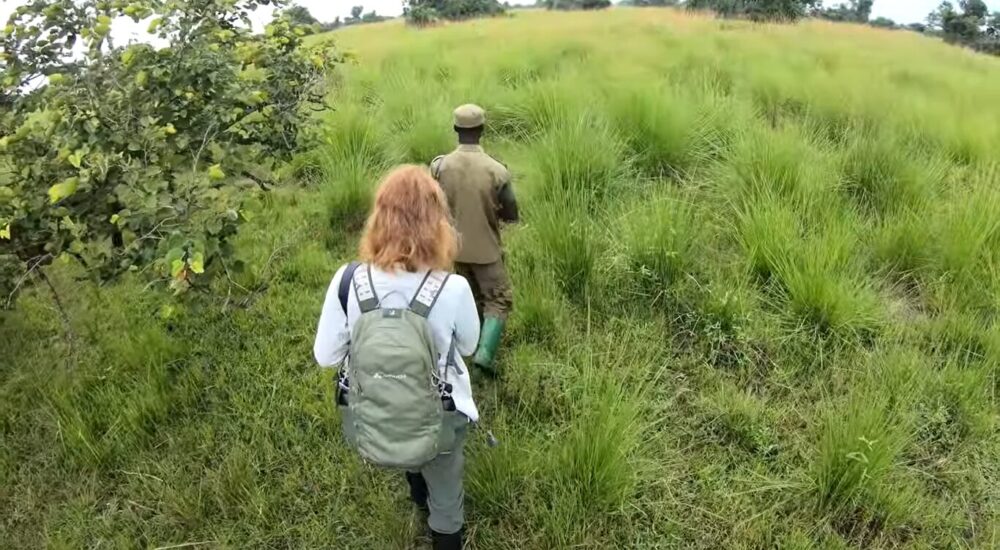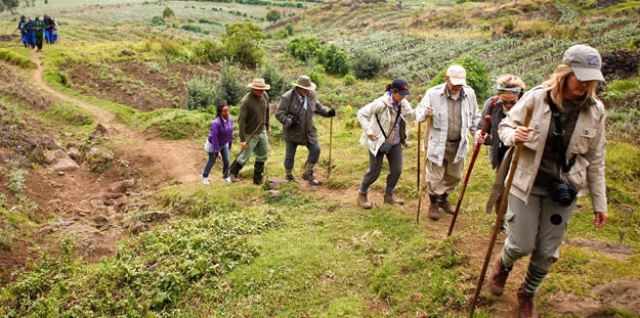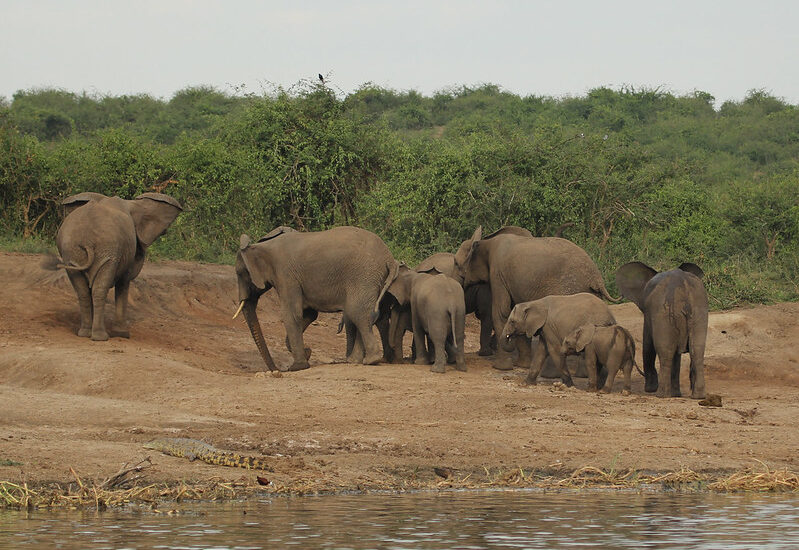Uganda, famously known as the Pearl of Africa, offers a diverse range of safari experiences,…
Mount Nyiragongo
A lot of people love to visit Mount Nyiragongo in the Democratic Republic of the Congo. One of eight volcanoes in the Virunga protection zone is Nyiragongo. It is in the east of the country and looks out over Virunga National Park. As well as these, there are Mount Karisimbi, Mount Bisoke, Mount Muhabura, Mount Sabyinyo, Mount Mikeno, Mount Gahinga, and Mount Nyamuragira. It takes about 5 to 6 hours to climb the 3470 meters of the Nyiragongo volcano to the top.
As one of the biggest active volcanoes in the world, Mount Nyiragongo’s lava lake is very interesting and beautiful. In 2014, officials at Virunga National Park started letting people go on hikes up Mount Nyiragongo. Mountain gorilla climbing and hiking up the Nyiragongo volcano are often done at the same time by tourists. If you want to go on a unique, once-in-a-lifetime mountain hike, Mount Nyiragongo is the place to go. It is the only place in Africa where people can get close to a lava lake. You might also be interested in information about Mount Kilimanjaro or how to climb it.
How to Get to Nyiragongo
Many places make it possible to reach Mount Nyiragongo, but for safety reasons, Gisenyi town in Rwanda is the best choice. Before going to Goma, tourists will be taken 20 kilometers from Gisenyi to the border between Rwanda and the Democratic Republic of the Congo. A big black cloud that can be seen from Goma town is a reminder of the last time the volcano erupted, in 2022. The lava used to be very hot and flow, but now it’s cool and hard like a rock. You will be taken to the start at Kibati hamlet after following Goma. You will be told what to expect before you start your Mount Nyiragongo volcanic walk. The lesson goes over all the important parts of trekking the Nyiragongo Volcano, like what to expect, where to stop, and what to bring. For the most part of the action, hikers will need to go together, except for the last part of the trip.
Hike up Mount Nyiragongo
People who aren’t fit or well-prepared may have a very hard time hiking Mount Nyiragongo. You have to be ready to deal with steep hills and rough landscapes. At the start, at the Kibati Ranger post, you can pay for a porter to help you carry big things. Getting together as a team with the cooks and other hikers after the meeting at 9 a.m. There are five steps to take to get to the top of Mount Nyiragongo.
The first part of the trip involves going up through lower-lying areas. People who aren’t mentally or physically ready often give up at this point. The air goes up after the first big stop, which causes new problems. In the second part of the trip, you’ll have to deal with small, loose lava rocks. People who have good climbing shoes should have no trouble with this stretch.
After finishing the second stretch, hikers have to deal with bigger rocks, slippery rocks, and rough conditions at high elevation. Finally, in the fourth part, the mountain slopes get steeper and steeper, and it gets colder because of the high elevation. Along with being cold, this area gets a lot of rain, so warm clothes and raincoats are a good idea.
It’s the highest and shortest in the last part. From here, you can see the cabins, which is enough to get even the most tired hiker motivated. People who hike to this point can finish the rest of the trail whenever they want. Our 4-day Nyiragongo hike package might be something you’d be interested in.
Stay the night at the Nyiragongo lava cabins.
There are 12 summit huts at the top of the hill. Each one has two single mattresses for climbers to sleep on. Each house has a bed with a mattress and a pillow. At the cabin, hikers are given food, breakfast, dinner, water, and sleeping bags. When winds are strong, the peak top may be very cold. Bring warm clothes with you. Cooks and porters will help warm up the walkers by making hot tea and coffee. The cost of an overnight stay at the top is included in the price of the ticket. From the rooms, you can smell the lava as it boils and bubbles.
Getting Down
After looking at the hot lava lake and magma, it’s time to go down. Going down is much faster; it takes about three hours to get to the starting point. But things aren’t as easy as they look. It can be hard to climb down through rough rocks and steep places, and you need to be careful not to get hurt by the rocks. Going down is beautiful because you can see for a long time the huge Virunga National Park and faraway volcanoes like the Rwenzori Mountains in Uganda and Lake Kivu.
How much a Congo Visa costs and what you need to do to get one
There are two ways to buy a $300 Nyiragongo hiking permit: directly from Virunga National Park or through a tour company. Once you buy a Nyiragongo hiking pass, you can’t get your money back. You must first get a climbing permit before you can apply for a Congo visa. Each person needs to pay $105 for a tourist ticket to enter Congo. You can use this visa for 14 days from the date you enter the country. Besides the VISA, you need other papers to cross the border into Congo from Rwanda. You need both a current passport and a yellow fever vaccination card.
An experienced tour company should be able to help you get the VISA and set up transportation, lodging, and porters. Our 4 day Mount Nyiragongo Climbing Package is very interesting, and you will enjoy it.
What to Bring for Hiking Mount Nyiragongo
A rain jacket. This should be light so it doesn’t get in the way of your progress up the mountain. The rain jacket will keep you dry during the heavy rain.
Hiking boots: Hiking boots should have good grip (rubber soles), be comfortable, and keep your feet warm.
Warm clothes and a sleeping bag: it gets colder as you go up the mountain, so you should be ready for anything. It will be very cold at the top, so make sure you bring warm clothes. A cap, long underwear, thick socks, a sweater, and rain pants are what you’ll need.
You should bring water and a packed lunch with you because climbing Mount Nyiragongo might make you thirsty and hungry. Pack a lunch and drink a lot of water.
Hire a porter: At the base of the volcano, it costs about $15 per day to hire a porter. These porters are used to going up the hill several times a week, so they can easily carry heavy loads. In addition, they will help you climb the hardest parts of the mountain.
A hat and sunscreen will help when it rains a lot or when it’s hot and dry.
Camera and Binoculars: You can’t enjoy something so amazing without a good camera to record the moment. A live earthquake is something that very few people will ever get to see. Beautiful pictures will help you keep track of things and amaze your family and friends. Binoculars will help you see the beautiful views, especially as you go down the mountain.
Backpack: This is where you’d keep all of your tools, like phones, iPads, cameras, binoculars, and more. Make sure it won’t get wet.
You can use this to charge your iPads, computers, and phones while you’re in your summit cabin.
A Torch: At the top, there is no power. You can get solar light, but it’s not available everywhere. You’ll need a flashlight to get to the kitchen or bathroom.
How to hike up Mount Nyiragongo: what you need to know
When is the best time to hike up Mount Nyiragongo?
You can hike up Mount Nyiragongo any time of the year, but most people like to go during the dry season. From June to September, as well as December, January, and February, it is dry. During rainy seasons, the paths become more slippery, making them harder to walk on.
In good shape:
Climbing Mount Nyiragongo is hard and requires good health. Going up the mountain is harder because it gets steeper, but going down is harder because your knees and ankles hurt from the pressure. Unfortunately, the weather gets worse as you go higher in the mountains. This is something you should remember, especially if you are easily affected by big changes in the weather.
Getting your mind ready
It’s not enough to just be physically fit; you also need to be mentally ready. No matter what comes up, you have to be determined to finish the hike. A short walk on nearby rocks or hills might help your body and mind get ready for the big hike.
When you hike with a stick:
Hiking with a stick can help you stay balanced and keep your knees from hurting as you go up and down steep hills. At the beginning, climbing sticks are given out.
Make sure your things are safe:
Things that are important to you, like photos, money, and computers, should always be close by, even when you’re in a cabin with other hikers.
Having a yellow fever vaccine card is very important:
To get into Congo, you need to show your visa and proof that you know how to get a yellow fever shot. If you don’t have the card, you might not be able to get into Congo.
Note: To have a more complete and memorable experience, hike the Nyiragongo Volcano and go gorilla trekking in Congo at the same time.


